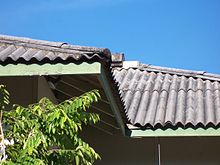Asbestos cement


Asbestos cement, genericized as fibro, fibrolite (short for "fibrous (or fibre) cement sheet"), or AC sheet, is a composite building material consisting of cement and asbestos fibres pressed into thin rigid sheets and other shapes.[1]
Invented at the end of the 19th century,
Asbestos cement is usually formed into flat or corrugated sheets or into pipes, but can be molded into any shape that can be formed using wet cement. In Europe, cement sheets came in a wide variety of shapes, while there was less variation in the US, due to labor and production costs. Although fibro was used in a number of countries, in
The use of fibro that contains asbestos has been banned in several countries, including Australia, but as recently as 2016,[update] the material was discovered in new components sold for construction projects.[5]
Health effects
When exposed to weathering and erosion, particularly when used on roofs, the surface deterioration of asbestos cement can release toxic airborne fibres.[6][7][8] Exposure to asbestos causes or increases the risk of several life-threatening diseases, including asbestosis, pleural mesothelioma (lung), and peritoneal mesothelioma (abdomen).
Safer asbestos-free fibre cement sheet is still readily available, but the reinforcing fibres are cellulose.[9] The name "fibro" is still traditionally applied to fibre cement.
Products used in the building industry

- Roofs - most usually on industrial or farmyard buildings and domestic garages.[10]
- Flat sheets for house walls and ceilings were usually 6 and 4.5 mm (0.24 and 0.18 in) thick, 900 and 1,200 mm (35 and 47 in) wide, and from 1,800 to 3,000 mm (71 to 118 in) long.
- Battens 50 mm (2.0 in) wide × 8 mm (0.31 in) thick, used to cover the joints in fibro sheets.
- "Super Six" corrugated roof sheeting and fencing.
- Internal wet area sheeting, "Tilux".
- Pipes of various sizes for water reticulation and drainage. Drainage pipes tend to be made of pitch fibre, with asbestos cement added to strengthen.[11]
- Moulded products ranging from plant pots to outdoor telephone cabinet roofs and cable pits.
Cleaning of asbestos cement
Some Australian states, such as
In popular culture
The 1973 song, "
See also
- Cemesto
- Eternit
- Fibre cement
- Transite, a brand of fibre cement originally produced as asbestos cement
References
- ^ "Asbestos Cement - Where it was used and how to identify it?". Asbestos-Sampling.com. Retrieved 2023-12-08.
- ^ "Asbestos Cement Sheets". Asbestos.com. The Mesothelioma Center. Retrieved 2020-01-20.
- ^ McLaughlin, Robert W.; Jandl, Henry A. (1959). Asbestos Cement: A Basic Building Material. Princeton, New Jersey: Princeton University School of Architecture.
- ^ "APT - Attitudes Towards Asphalt Roofing" (PDF). Docuri.com. Retrieved 7 September 2018.
- ^ Asbestos found in $1.2b Perth Children's Hospital, says WA Health Minister, ABC News, 14 July 2016, retrieved 3 October 2016
- PMID 19491148. Retrieved 7 September 2018.
- PMID 21924550.
- S2CID 1665347. Retrieved September 6, 2023.)
{{cite journal}}: CS1 maint: numeric names: authors list (link - ^ "Fibre Cement". Consumer Build.
- ^ "Asbestos Cement - Where it was used and how to identify it?". Asbestos-Sampling.com. Retrieved 2021-10-06.
- ^ "Where can you find asbestos? Asbestos cement". Hse.gov.uk. Retrieved 7 September 2018.
- ^ "Prohibited use of water blasters (poster)" (PDF). Queensland Government.
